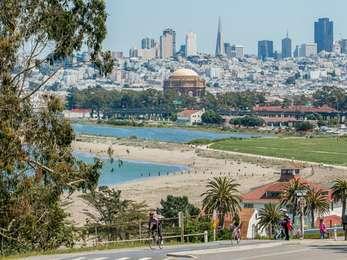Last updated: March 24, 2021
Place
5 - A Story of Sustainable Living

WAYSIDE PANEL TITLE: A Story of Sustainable Living.
PANEL DESCRIPTION: The wayside faces east, on the east side of the trail.
VIEW FROM WAYSIDE: Facing east, to the left, or north, is a path to the East Beach parking lot and the San Francisco Bay Trail. The trail goes east to East Beach and the Crissy Field Center, and west to Crissy Field. Directly behind the wayside and to the right are several picnic tables and barbecues. There are more picnic tables and barbecues on the right of the path to the left. Visible in the distance to the north west is the Golden Gate Bridge. A large willow stands directly in front of the wayside, and a few feet to the right across the trail are both a trash and recycling bin. Cypress trees offer some shade to cars in the parking lot near East Beach, to the right of them, you can see the bathroom building at the far end of the grassy field that starts to your right.
NOTE: This exhibit was prepared in collaboration with the Ohlone community. Illustrations and text courtesy of Linda Yamane, Rumsien Ohlone.
TEXT: Traditional Uses of Native Plants. Ohlone people used plants for food, tools, building materials, boats, baskets, twine, medicines, musical instruments, games and more. Their small population and their understanding of plants made it possible for them to use resources without depleting them. Today, we must be careful not to overuse what remains. We can, however, learn from Ohlone tradition, seeing native plants with renewed respect and appreciating the resourcefulness of this area's first people. As part of the restoration of Crissy Field, the National Park Service reintroduced many native plant species, including several shown here, which were traditionally used by the Ohlone.
DESCRIPTION OF ILLUSTRATION #1: An illustration of a wispy, feathery-leafed plant next to a woven basket. The basket is two-toned, with a ring of black triangles pointing downward along the top and inside lip of the basket. A similar pattern is continued further down, with a solid black ring making its way around the basket, with a series of angled quadrilateral shape, like a trapezoid, extending down from it. The space between these four-sided shapes forms a rectangle, the bottom edges of which, serve as the base of another row of black triangles.
CAPTION: Bracken Fern, Pteridium aquilinum, Spanish: Manita, Rumsien Ohlone: Witt (pronounced: WEET). Traditionally, bracken fern fronds were used as umbrellas, roof-thatching and the lining of earth ovens or acorn-leaching basins. The underground runner contains a dark band of material that is used to create patterns in basketry.
DESCRIPTION OF ILLUSTRATION #2: An illustration of the basket and fern is another illustration of a plant, one with slender oval leaves and a light green coloration.
CAPTION: Arroyo willow, Salix lasiolepis. Spanish: Sauz de la oja finite. Mutsun Ohlone: Tarhasan (pronounched TAR-hah-sahn). Willows have served Ohlone people for countless generations, providing framework for thatched houses, a pain reliever found in the bark, and material for weaving the various baskets so important in everyday life.
DESCRIPTION OF ILLUSTRATION #3: An illustration of another plant and its root bulb. The plant has long, curling leaves that all stem from the center of the plant, just above the bulb. Next to this is an illustration of a hand holding a thick paint brush going over a woven basket.
CAPTION: Soap root, Chlorogalum pomeridianum. Spanish: Amole. Mutsun Ohlone: Torow (pronounced: to-RO). The bulb of this plant, when mixed with water, lathers into a fine soap or shampoo. The brown fibers that surround the bulb are tied into sturdy little brushes that are used when preparing acorn meal. In the past, the edible bulbs were baked into underground ovens or crushed and placed in water to stupefy fish for an easy catch.
DESCRIPTION OF ILLUSTRATION #4: A plant with a long, tall stalk with pairs of round leaves growing at intervals to its top. The leaves are fairly round but come to a point at their end and are a bluish-green color.
CAPTION: Yerba Buena, Satureja douglasii. Spanish: Yerba Buena. Rumsien Ohlone: Tcawricim (pronounced: CHOW-reesh-eem). The city of San Francisco was first named for this aromatic little mint, which means "good herb" in Spanish. Ohlone people have long valued the medicinal properties of yerba buena, drinking it as a tea for good health.
DESCRIPTION OF ILLUSTRATION #5: The second plant illustration shows a bright orange bowl or bell shaped flower rising above the green stalks below. Two orange cones, unopened blossoms, are visible lower on the plant.
CAPTION: California poppy, Eschscholtzia californica. Spanish: Amapolla. Rumsien Ohlone: Cululuk (pronounced: SHOO-loo-look). While it is well known today as the state flower, did you know that Ohlone people once brewed poppy flowers into a remedy for head lice? They also placed these flowers beneath a child's bed to encourage sleep.
TEXT: What is a Dune Swale? The area in front of you is known as a dune swale. Lying below the water table between sand dunes, these depressions seasonally pool freshwater that seeps up through the soil. The freshwater sustains plants, such as those shown here, that are less tolerant of the salty dunes and tidal marsh.
DIRECTIONS TO NEXT WAYSIDE: To the right of the wayside, follow the path right as it curves around the trash cans and heads north west. You'll pass four picnic tables and barbecues on the right. Walk 280 feet until you reach the next wayside to the left of the path facing west.
